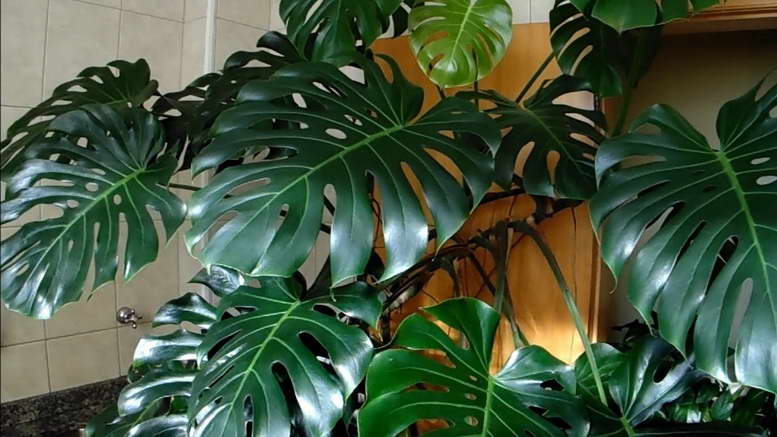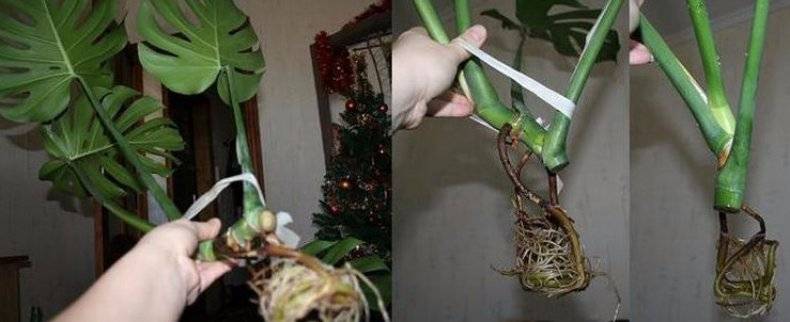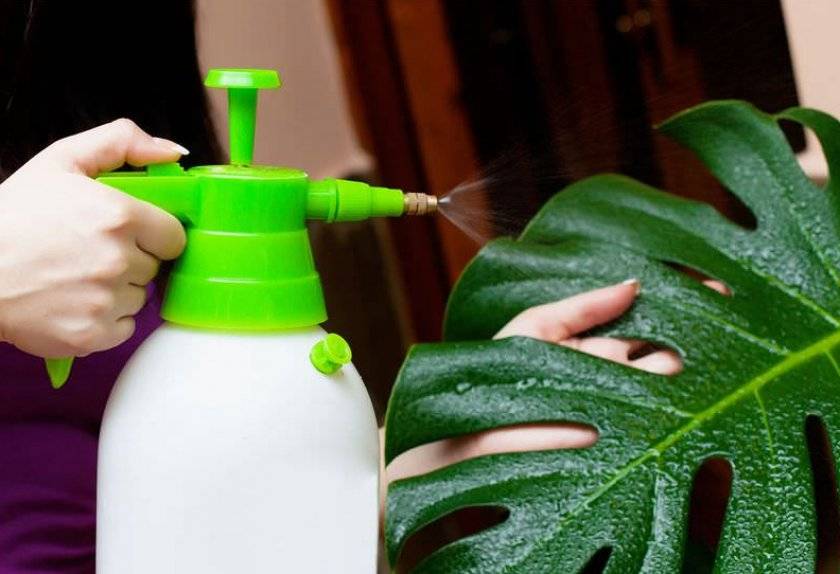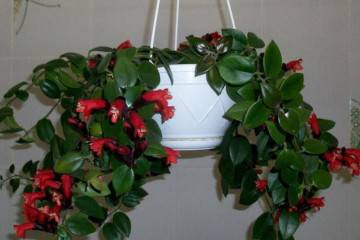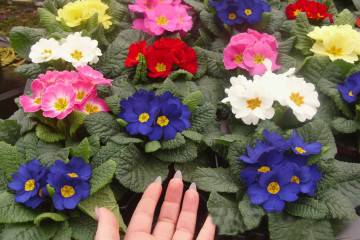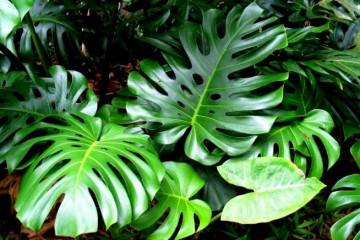Monstera - breeding at home
Content:
Surely everyone has heard of such a plant as a monstera. But how you can propagate it at home, what kind of care will speed up rooting, and how to care for a young offshoot, few know. The article below explains this in detail.
Monstera: breeding at home and its principles
Monstera is a representative of the tropics. Reproduction at home can be carried out in different ways, but subject to high humidity, sufficient lighting and heat. Therefore, it is important to strictly and unswervingly adhere to the following principles:
- the cuttings are rooted in the sand, after the roots appear, they are planted in the ground. And all this at a temperature fluctuating between 22-25 ° C;
- this flower is photophilous, so the room with cuttings should be sufficiently lit. But, on the other hand, you should not put a flowerpot with seeds or cuttings under the scorching rays, this is fraught with burns;
- the key to successful rooting is high humidity in the room, so it is worth spraying the flower twice a day;
- rooted seedlings should be fed every 2 weeks with a weak solution of complex and organic fertilizers.
How monstera reproduces
Florists identify several ways, each of which has its pros and cons.
How to breed a monsterstem cuttings
Experienced gardeners call this the easiest and fastest breeding method. How to get a scion from a monstera? A stalk can be obtained from a growing flower. A small twig is cut from a stem with 2 buds, which is then placed on the surface of the soil.
How to plant a monstera shoot: the stalk should be placed in the ground so that its bud touches the ground, then sprinkle it with earth and water it. To create and maintain the proper level of humidity and temperature, cover with glass or film, periodically raising it to ventilate and water the cutting.
Apical cuttings
In this case, you need to cut off the top of an adult plant and put it in water, where it will take root. It is advisable to keep the twig in water until three roots appear, and then plant it in the ground. Caring for a planted cuttings is simple, this issue will be discussed below.
Leaves
Only experienced flower growers know how to root a monster, or rather its leaf. This method works if you take a freshly cut leaf. Otherwise, the monster will not be able to dilute in this way, the leaf quickly loses its properties and strength, so it will not give roots.

Breeding a monstera with a leaf has its own characteristics, without the knowledge of which it will not be possible to grow a new specimen
Having cut off the leaf, you just need to put it in water and wait until the roots appear. To speed up the process, you can add a growth stimulant or several crystals of potassium permanganate to the water until a pale pink solution is obtained. After rooting, the leaf is planted in the ground.
How to propagate a monster at home inair roots
To do this, take a part of the monstera on which there is an aerial root (layering) and provide it with moisture. How to do it? Just wrap this area with moss and fix it, and then water it regularly.
The main thing is not to tie the moss too tightly and not to fix it too tightly, leaving room for root growth. When this area grows a good volume of roots, an incision is made and the layers are separated, after which they are planted in a pot with nutritious soil.
How can a monster be propagated by seeds
In order for the result of labor to please, experienced gardeners do not recommend reproduction of monstera by seeds at home due to its unreliability and long process. In addition, it can be too difficult to get high-quality seeds for planting. But if you're lucky, after a year you can grow and get a small plant with 2-3 leaves.
Step-by-step instructions for planting seeds provide for a stable temperature within 22-24 ° C, bright but diffused lighting to obtain high germination of seeds. Otherwise, at high temperatures and under the scorching sun, they will die.
Seeds are spread in light and nutritious soil, covered with foil or glass, periodically raising them, airing and watering.
For your information! The seeds will show the first shoots after 1-1.5 months, and when they get stronger, they will need to be transplanted in separate pots. Six months later, young shoots will give the first true leaves.
But before planting the seeds in the ground, they will need to be scarified and soaked. What is scarification? This is a slight damage to the hard shell of the seed so that the sprout can hatch through it. This can be done with a nail file or other object with an abrasive surface.
After that, the seeds are soaked for several hours in warm pre-boiled water. It is best to add a few crystals of potassium permanganate to it so that a pale pink solution is obtained. Or, as an option, you can soak in water with a growth stimulant.
Further care
The care of young plants has its own rules and recommendations.
- Shine. For fast, and most importantly, successful rooting and growth, the plant needs a lot of light, but not direct, but diffused. Direct sunlight is detrimental to the monstera, as young shoots can get burned. It is optimal to put a flowerpot with a handle on the east side.
- Watering. Since the monstera is a native of the tropics, it needs abundant and regular watering, especially during the period of active rooting and growth of young cuttings and germination of seeds. But it is worth watering carefully: they take settled water and bring it into the soil not at the root, but at first from a spray bottle.
- Air humidity is an important condition for rooting of the cuttings and germination of seeds. Therefore, after planting in the ground, they should be regularly sprayed and covered with film or glass, creating the effect of a greenhouse. But do not forget to ventilate them, since the lack of regular air access will lead to the development of pathogenic fungi and the death of plants.
Optimal rooting conditions
Detailed care instructions provide for compliance with a number of conditions.
- Monstera grows quickly, so when planting even a small cuttings, you should choose a large flowerpot. The root system develops quickly, after 2-3 months the plant will have to be transplanted.
- Another important condition for active rooting and growth of cuttings and seeds is the temperature regime. The warmer it will be in the room, the more actively the stalk will grow and take root faster, and its foliage will have impressive dimensions.
- Fertilization for planting is required.The monstera requires nutrients to accelerate growth and establishment. It is their stalk that will receive along with the introduced top dressing.
- As the cutting grows, it is worth installing a support under it so that the young branches do not break. These can be plastic sticks or wooden bars.
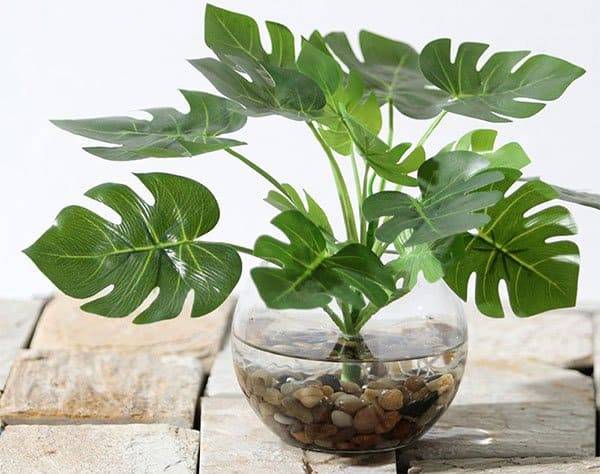
Rooting takes place quickly, so it is worth knowing in advance how to plant the monster, because the procedure will have to be carried out often
Possible problems
In order for the monstera not only to take root after reproduction, but also to please with external decorative characteristics, during reproduction and care it is worth excluding the most frequent mistakes and errors.
- Reproduction and repotting are best done in spring or summer, when the outside temperature and the length of daylight hours create favorable conditions for this.
- It is important to pay attention to the quality of the soil, its nutritional value and the size of the flowerpot. Monstera grows quickly and is high in nutrients. If planted in a nice little pot, the soil itself will quickly become poor in nutrients, and the monstera will grow slowly.
- The planted stalk grows exclusively upward, but not in width. So that it does not break in a narrow place, it is sprinkled with earth in a flowerpot or a support is placed.
- If the foliage wilted or began to turn yellow, fall off, this indicates a lack of moisture in the soil, low air humidity. If the foliage falls off in the fall, the flower pot should be moved away from the battery or other source of heat.
- Often, after watering or before the rain, the leaves can seem to cry. This is normal, so don't worry.
Foliage can often lose its bright color, becoming transparent. In this case, there is an overabundance of light. The plant should be removed away from sunlight. In all other respects, caring for a monster, its reproduction - tasks that are feasible even for a beginner. In terms of cultivation, the flower is unpretentious and undemanding.
